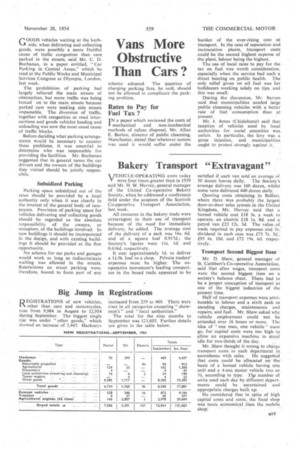Bakery Transport "Extravagant"
Page 53

If you've noticed an error in this article please click here to report it so we can fix it.
TEHICLE-OPERATING costs today V were four times greater than in 1939 said Mr. H. W. Harvey, general manager of the United Co-operative Bakery Society, when he addressed a conference held under the auspices of the Scottish Co-pperative Transport Association, last week.
All concerns in the bakery trade were extravagant in their use of transport because of the need for immediate delivery, he added. The average cost of the delivery of a sack was 1.6s. 6d. and of a square loaf 0.917d.; the Society's figures were I Is. Id. and 0.616d. respectively.
It cost approximately Id, to deliver a 1/-lb. loaf to a shop. Private traders' expenses must be higher. The cooperative movement's leading competitor in the bread trade appeared to be satisfied if each van sold an average of 50 dozen loaves daily. The Society's average delivery was 160 dozen, whilst some vans delivered 440 dozen daily.
Quoting costs obtaining in Belfast, where there was probably the largest door-to-door sales system in the United Kingdom, Mr. Harvey said that a horsed vehicle cost £18 3s, a week to operate, an electric £18 Is. 8d. and a petrol van £23 12s. 3d. The value of trade required to pay expenses and Is.' dividend in each case was £73 7s. 3d.. £95 4s. 10d. and £72 19s. 6d, respectively.
Transport Second Biggest Item
Mr. D. Shaw, general manager of St. Cuthbert's Co-operative Association, said that after wages, transport costs were the second biggest item on a society's balance sheet. There had to be a proper conception of transport as one of the biggest industries of the present time.
Half of transport expenses were attributable to labour and a sixth each to standing charges, maintenance and repairs, and fuel. Mr. Shaw asked why vehicle employment could not be extended over 16 hours or more. The idea of "one man, one vehicle" must go, for capital costs were too high, to allow an expensive machine to stand idle for two-thirds of the day.
Mr. Shaw thought it wrong to charge transport costs to each department in accordance with sales. He suggested that costs could be allocated on The basis of a horsed vehicle having one unit and a 4-ton motor vehicle two or 3+, according to type. TII,e number of units used each day by different departments could be ascertained and appropriate charges built up.
He considered that in spite of high capital costs and rents, the fixed shop was more economical than the mobile shop.




























































































